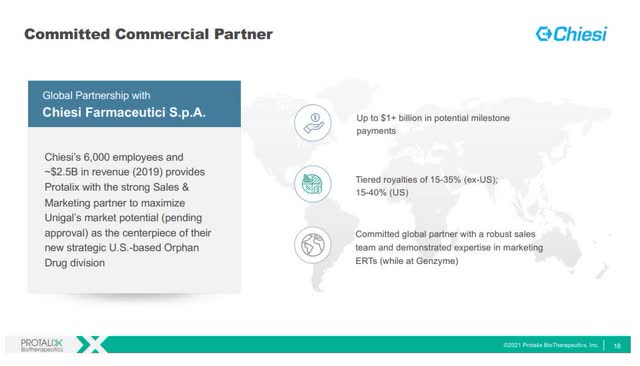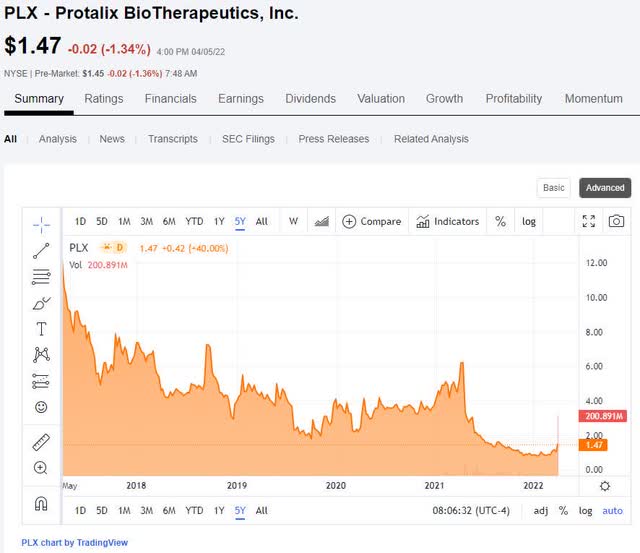Halfpoint/iStock via Getty Images
Introduction
For Protalix’s (NYSE:PLX) investors, the completion of BALANCE, PLX’s p3 Fabry head-to-head comparison trial against Sanofi’s Fabrazyme must feel like finishing a marathon race.
(PLX 5-year chart ending on April 5, 2022)
BALANCE was first started in 2016 as a 2-year study, whose original primary endpoint was superior renal efficacy, i.e. “a 30% improvement in the rate of decline in eGFR relative to the active comparator arm [Fabrazyme].”
Sanofi’s Fabrazyme was the leading ERT (enzyme replacement therapy) for Fabry patients, and the only approved Fabry ERT in the US (accelerated approval in 2003, and regular approval for Fabry patients age 2 and older in 2020).
On April 4 PR, PLX stated:
As first announced in October 2021, as part of a Type A End-of-Review meeting, the U.S. Food and Drug Administration (FDA), in principle, agreed that the proposed analysis of the BALANCE study demonstrating non-inferiority to agalsidase beta included in the data package for the PRX-102 biologics license application (BLA) resubmission has the potential to support the approval of PRX-102 for the treatment of Fabry disease. (Emphasis added)
However, I note that there’s no mention about the change in endpoint (“30% improvement” to “non-inferiority”) in PLX’s Oct 2021 update (see below):
The Type A meeting was held on September 9, 2021. As part of the meeting minutes provided by the FDA, which included the preliminary comments and meeting discussion, the FDA, in principle, agreed that the data package proposed to the FDA for the BLA resubmission has the potential to support a traditional approval of PRX-102 for the treatment of Fabry disease. The planned data package for the BLA resubmission, given the changed regulatory landscape in the United States, will include the final two-year analyses of the phase III BALANCE clinical trial. (Emphasis added)
Nor was the change in primary endpoint (from superiority to non-inferiority) mentioned in this Oct 15, 2021 PR announcing the final dosing of BALANCE’s last patient.
Regardless when or if PLX indeed announced the change of primary endpoint, let us now turn to the topline (non-inferiority) data from BALANCE.
BALANCE’s 24 months topline data
I will briefly summarize BALANCE topline data in the table below, and afterwards discuss a few notable points.
The results in BOLD font represent the better data points, numerically speaking (not statistically).
|
PRX-102 group (n=52, at baseline) (n=47, at 24 months) |
Fabrazyme group (n=25, at baseline) (n=24, at 24 months) |
|
| Renal Efficacy data | ||
|
The medium eGFR slope (mL/min/1.73 m2/year) |
-2.514 | -2.155 |
| Safety data | ||
| % of patients experience at least one adverse event | 90.4% | 96% |
| % of patients experience treatment related adverse event | 40.4% | 44% |
| The number of infusion-related reactions adjusted to 100 infusions | 0.5 | 3.9 |
|
Number of patients (% of total group) who are ADA (anti-drug-antibody) positive at the baseline |
18 (34.6%) |
8 (32%) |
| Number of patients (% of ADA+ patients*) who has neutralizing antibody activity [against the drug] at the baseline | 17 (*94.4%) | 7 (*87.5%) |
| Number of patients (% of total group) who are ADA (anti-drug-antibody) positive at 24 month | 11 (23.4%) | 6 (26.1%) |
| Number of patients (% of ADA+ patients*) who has neutralizing antibody activity [against the drug] at 24 month | 7 (*63.6%) | 6 (*100%) |
| Number of patients (% of total group) discontinued in the trial | 5 (9.4%) | 1 (4%) |
| Number of deaths | 0 | 0 |
(Source)
Notes:
*The way that the % in patients who have neutralizing antibody activity is calculated differently from other percentages (which are based on the entire group), being the % of those patients who are ADA+. For example, the 100% in Fabrazyme group at the end of the study indicates that all 6 of the ADA+ patients showed anti-drug antibody activity (not to be confused with a % of the entire Fabrazyme group at the end of the study, 6/24).
In other words, in this safety measurement, PRX102 group went from 17 out of 18 ADA-positive-patients who showed neutralizing antibody activity, down to 7/11 vs. Fabrazyme’s 7/8 to 6/6.
From the baseline to 24 month, the trend for ADA+ & anti-drug neutralizing antibody is the same for both drugs (decrease in the number of patients), though to a greater degree in the PRX-102 group.
Some additional comments:
- Although, PRX-102 has shown better safety data, i.e. “favorable tolerability and immunogenicity profile”, this did not translate to a better renal efficacy data.
- Numerically speaking, the Fabrazyme group showed a better e-GFR slope data, i.e. a smaller absolute value (2.155 in Fabrazyme vs. 2.514); which translates to a slower decline in kidney function.
- The discontinuation rate in the Fabrazyme group is smaller (better) than PRX-102 group (4% in Fabrazyme vs. 9.4% in PRX-102).
Investment consideration
Firstly, as I mentioned earlier, I could not find when/where PLX has disclosed that the FDA has agreed to changing the primary endpoint of BALANCE from superiority (or 30% improvement in eGFR slope), first agreed in 2016, to non-inferiority.
Such a change was not explicitly stated in the Oct 11, 2021 PR, though it is referred to in April 4 PR, as if it had been previously disclosed.
If it’s true that the FDA has recently agreed to this change of primary endpoint, it’s indeed a very fortunate/timely change for PLX, as otherwise, BALANCE would have completely failed its primary endpoint (a 30% improvement in eGFR slope over Fabrazyme).
Secondly, it’s worth noting that in Sanofi’s 2020 PR about Fabrazyme’s regular approval, Sanofi reported:
In a real-world observational study, the estimated mean eGFR slope was -1.5 mL/min/1.73 m2/year in the Fabrazyme-treated group…
(Source; emphasis added)
This is much better renal efficacy data, numerically speaking of course, than what was seen in PLX’s BALANCE.
In other words, although PLX can claim that PRX-102 is “non-inferior” in renal efficacy to Fabrazyme in BALANCE, Fabrazyme’s real-world data may paint a different picture for Fabry patients and their physicians, when considering efficacy of available treatments.
Thirdly, in this important 2015 paper on Fabry Disease, the author concludes:
Patients who initiated treatment at a younger age and with less kidney involvement benefited the most from therapy.
Both Takeda (Shire’s) Replagal and Sanofi’s Fabrazyme are approved for pediatric use (Replagal in the EU only, Fabrazyme in the US and EU), while PLX has not conducted any pediatric trials.
All three PLX’s phase 3 Fabry trials (BRIDGE, BRIGHT, BALANCE) studied adult Fabry patients only.
Conclusion
PLX’s Fabry program has finally arrived at a finish line of sorts, with the completion of BALANCE, PLX’s only randomized, controlled (with an active comparator control vs. open-label without a control) phase 3 Fabry trial.
It all goes well from now on, the company plans to resubmit their application to the FDA in the second half of 2022.
Needless to say, the company and the investors share a great hope for PRX-102’s market potential (up to >$1B in potential milestone payments). See below.
According to this market report, the global Fabry drug market in 2021 was ~$2.1B.
Protalix Nov 2021 Presentation
If PRX-102 is approved, it would be the fourth Fabry treatment in the EU after Sanofi and Shire’s ERT and Amicus’ Galaford (an oral treatment) and the third in the US (Shire’s ERT is not approved in the US).
In other words, PRX-102 would not be the first-in-class Fabry drug, and in terms of renal efficacy, it is certainly not the best-in-class Fabry drug (only a non-inferior ERT [to Fabrazyme] for adults, where the need is not as urgent as for young children diagnosed of Fabry Disease).
Furthermore, as stated recently, I believe that results from BRIGHT will not support the approval of a 4-week regime of PRX-102, which would have been an advantage over the 2-week regime of currently available ERTs.
Having said all this, I do understand that the short-term price action of small/micro biotech stocks are driven by many factors, e.g. speculative FOMO, penny stock/momentum trading, wider market volatility, besides the trial data or profitability of the company.
In my opinion, for long-term investors, the most significant risk is that PRX-102’s prospect may not be sufficiently strong to ensure a real (sustained) turn-around in this stock, as:
- Regulatory approval, in the EU and/or in the US, is not a sure thing;
- If approved, it is a late comer without superiority in renal efficacy to compete in the established Fabry drug market;
- Studies/approval for pediatric use is very far away, if ever.
Thanks for reading. All the best!



Be the first to comment